DNA Replication and Telomeres (9/4-9/6)
1/34
Name | Mastery | Learn | Test | Matching | Spaced |
|---|
No study sessions yet.
35 Terms
Semi-Conservative
One strand serves as the template
Bi-Directional (Hint: 2)
DNA synthesis initiates at an origin of replication and proceeds outwards in opposite directions
A replication bubble with two replication forks
Semi-Discontinuous
The entire DNA replication process that has both continuous and discontinuous processes
Replication Bubble
An open region of DNA where the double helix has been unwound, allowing DNA replication to occur
DNA Helicase (Hint: 3)
Binds at the replication origin
Moves away from each other
Unwind parental DNA strands forming a replication bubble with two replication forks

DNA Gyrase (Topioisomerase)
Removes supercoiling stress

Single-Stranded Binding (SSB) Proteins (Hint: 2)
Protect DNA
Stops from reforming double-stranded DNA
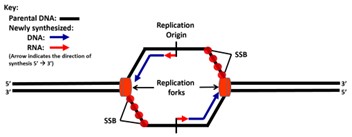
Primase
Synthesizes a complementary RNA primer at the origin on both parental strands
DNA Polymerase III (Hint: 2)
Catalyzes the addition of complementary nucleotides to the 3’-OH of the newly made strand
Synthesizes in the 5’→ 3’ direction ONLY
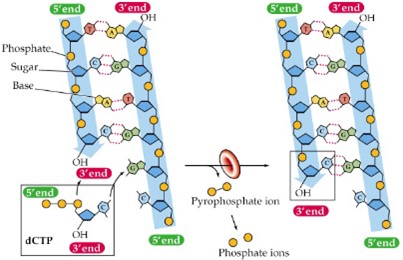
RNA Primer
Provides 3’-OH for DNA polymerase III
Leading Strand
DNA polymerase III adds complementary DNA nucleotides to the RNA primer
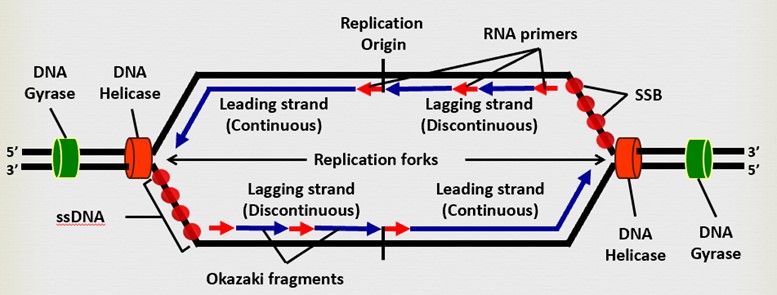
Continuous Strand
Leading strand
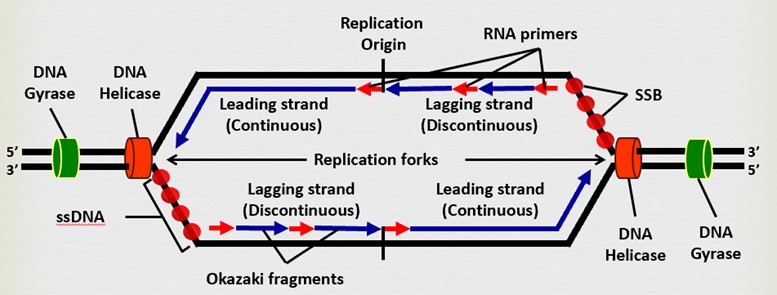
Lagging Strand
Once enough of the parental DNA is unwound, primase lays down another complementary RNA primer
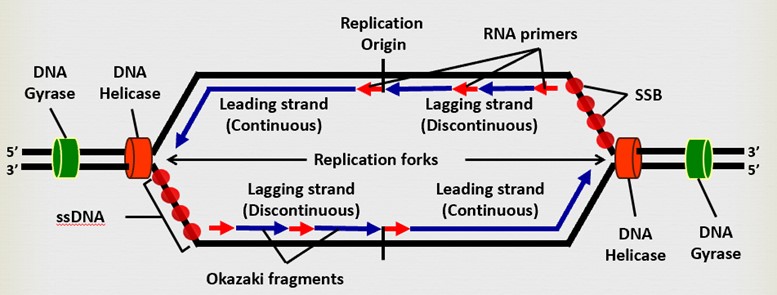
Discontinuous Strand
Lagging strand
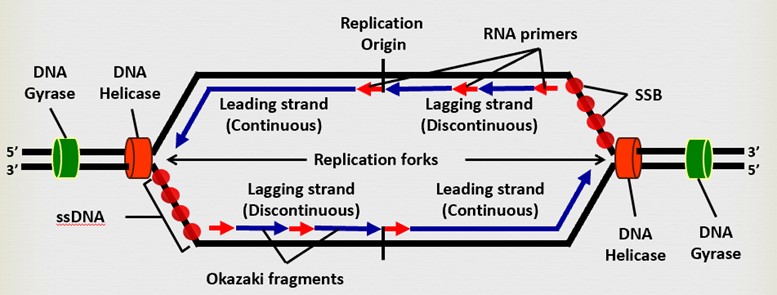
Okazaki Fragments (Hint: 2)
DNA polymerase III extends until it hits the previous primer
Small sections of DNA that are formed during discontinuous synthesis of the lagging strand during DNA replication
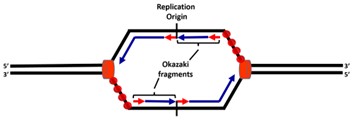
Proofreading (Hint: 2)
DNA polymerase III can move “backwards” and excise an incorrect base and add the correct base
3’ to 5’ proofreading activity
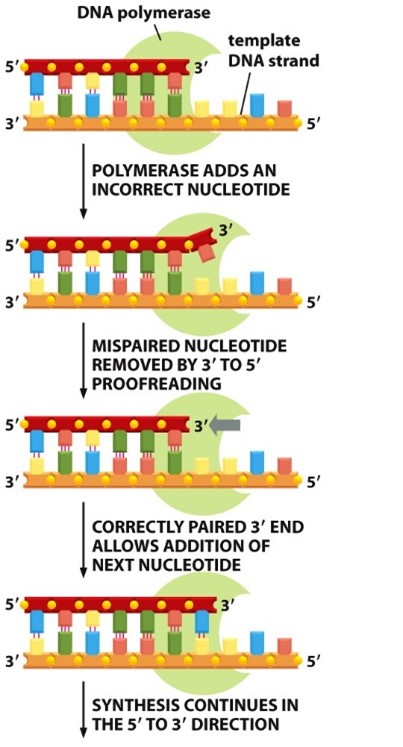
Exonuclease
Remove a base from the end
DNA Polymerase I
Removes the RNA primer and fills in the gap with DNA nucleotides
DNA Ligase (Hint: 2)
Covalently links the ends together resulting in a seamless strand of DNA
Works with DNA polymerase I to link Okazaki fragments together
Replication Fork
Move away from the origin in a bidirectional fashion
End Replication Problem (Hint: 7)
On the lagging strand
Lagging strand lays down a primer
Removed at 5’ end
Can’t be filled in because there is no 3’-OH to attach DNA nucleotides to
Single stranded DNA can break and be lost
Results in shortened chromosome
Over many divisions chromosomes shortening can lead to loss of gene information near the chromosome ends
Telomeres (Hint: 5)
The ends of the chromosomes
Composed of hundreds of repeats
Protects the ends of chromosomes from degradation
Prevents ends from fusing
Overcomes the end replication problem
Telomerase
An enzyme that uses an RNA template to extend the 3’ end of chromosomes
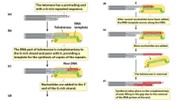
Telomere Repeat
A G-rich repetitive sequence telomerase synthesizes so a primer can be synthesized and the end can be replicated

When does DNA replication take place in the cell cycle?
S phase
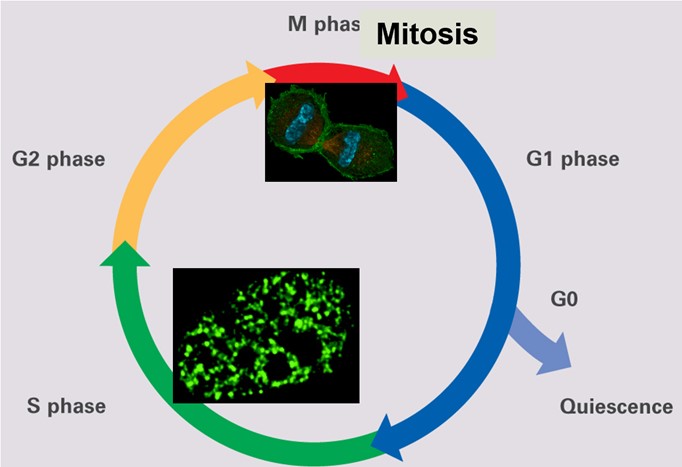
What are the 3 hallmarks of DNA replication?
Semi-Conservative
Bi-Directional
Semi-Discontinuous
Replicator of DNA Replication
The origin of replication
Initiator of DNA replication
Protein(s) that bind the origin and initiate replication
Origin of Replication
Site where DNA replication starts
Be able to fill in a blank DNA replication bubble with RNA primers, leading/lagging strands (continuous/discontinuous strands), helicase, replication forks and replication origin.
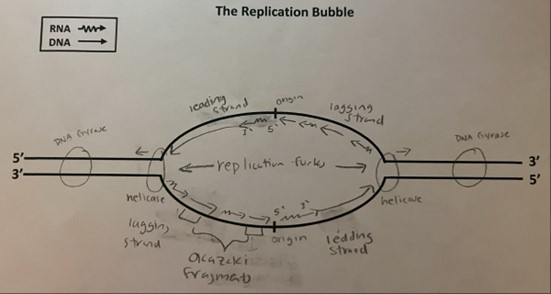
Proofreading: Why does the direction of proofreading mean that polymerization only occurs in the 5’-> 3’ direction?
Reaction could not proceed because there would be no high energy bond to cleave
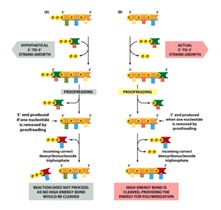
What is the sequence of the human telomere repeat?
TTAGGG
Where (what types of cells) is telomerase usually expressed?
Expressed in actively dividing cells- single celled organisms, germ cells, early embryos, stem cells, bone marrow, intestinal epithelium, hair follicles
What are 2 of the conditions that are associated with shortened telomeres?
Aging
Werner’s Syndrome: Premature aging syndrome associated with shortened telomeres
Why do cancer cells express telomerase?
Necessary to keep dividing